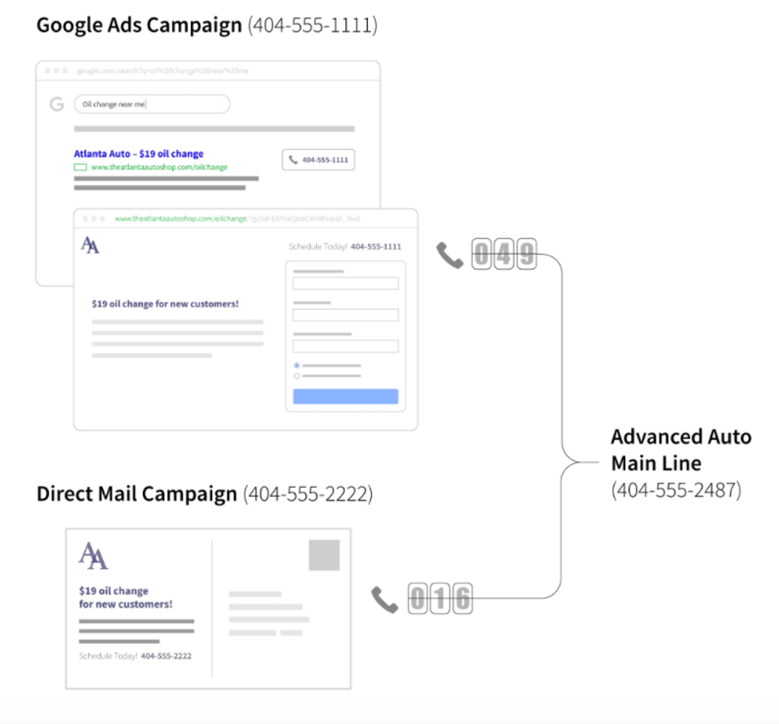Do you want more leads for your business?
In the past, most businesses focused on outbound marketing tactics such as direct mail, radio spots, TV commercials, and newspaper advertising to drive traffic.
Now, there is a more cost-effective way to reach your customers where and when it counts and to see what marketing efforts are working.
In this article, we’ll discuss the benefits of inbound marketing and how to use inbound marketing tactics to generate leads.
What Is Inbound Marketing?
Inbound marketing allows brands to attract their ideal customers using a variety of optimized content that addresses customer pain points and needs geared towards specific stages in the buyer’s journey.
For example, businesses will use videos, blog posts, podcasts, and social media content to build brand awareness and help introduce potential customers to their brand.
And these inbound marketing efforts are paying off.
A CallRail survey of 600 small business owners across industries revealed that investing in social media, email, and content marketing contributed to gaining 20 leads on average per week.
Once potential customers have gotten to know the brand and its products or services, content including original research, white papers, case studies, and webinars can help customers with their purchasing decision.
Most importantly, these types of in-depth content also allow your business to collect contact information from leads (potential customers who have expressed interest) and follow up with them based on their contact preferences.
Inbound Marketing & SEO
Search engine optimization (SEO) plays a vital role in the success of your inbound marketing. Everything you publish online for your business needs to be optimized to help your customers find your content via search.
Here’s why.
According to data from SimilarWeb and GrowthBadger, Google drives 8x more traffic than social media. Businesses in industries like Health & Medical, Travel, Design & Development, Personal Finance, Fashion & Beauty, Food & Recipes, and Business & Marketing acquire more than half of their traffic from search engines.
Across all industries, websites received an average of 60.68% of traffic from search, 6.44% from social, and 3.64% from referral links.
StatCounter’s Global Stats report shows Google as the top search engine with 92.03% global market share. Google is followed by Bing, Yahoo, Baidu, Yandex, and DuckDuckGo.
Optimization for search engines benefits all aspects of your inbound marketing, beyond your website content in Google.
- Most social networks – including Facebook, Instagram, Twitter, and LinkedIn – have their own search engines to help users find relevant social content.
- Email programs like Gmail and Outlook have search boxes so email users can find specific email content they may have archived.
- Professional directories like Nolo have built-in search engines to help their users find specific legal content and attorneys in their area.
So, if you think you only need to optimize your website content for search, you could be missing out on potential leads from social media searches, email inbox searches, and local directory searches.
With that said, incorporating an SEO strategy into your marketing efforts is a long-term process.
Depending on the keywords you want to rank for, it could take months or even years to get your content to show up (or rank) on the first page of search results. This is especially true if you are starting from scratch with no rankings.
But as you start ranking higher in organic search, you will see your inbound traffic from search engines increase because your content is recognized as providing the best, most relevant answers to questions people search for related to your services or products.
The best part?
As long as you maintain your rankings, which involves keeping your content updated and optimized for search, you will continue to receive traffic from search engines. If you are paying nothing to generate traffic from search and generating leads, your inbound marketing ROI will increase.
In the meantime, outbound marketing strategies and advertising can fill the traffic gap until you begin acquiring leads through your inbound marketing.
How to Improve Your Inbound Marketing
Here are five actionable tips that will help you increase the effectiveness of your inbound marketing strategy.
1. Create Educational Content for Your Customers
What questions do your customers ask before making the decision to purchase your product or service?
In CallRail’s ebook, 4 Inbound Marketing Ideas That’ll Make Your Phone Ring, they discuss how personal injury law firm Block OʼToole & Murphy created authoritative topic pages around their main legal services.
Topic pages break down legal issues in easy to understand language, answer Frequently Asked Questions, and display social proof (such as reviews from existing clients and press coverage).
The result of creating these topic pages: the law firm website attracts over 5,000 visitors from organic search results. They also rank for valuable keywords like “construction accident law firm” and “New York car accident lawyers.”
To get inspiration for your inbound content library, browse your top competitors’ websites — specifically the competitors that rank well in search for the keywords your business targets. To create the most comprehensive content, be sure to analyze:
- The main topics your competitor’s cover on their blog, ebooks, white papers, videos, etc.
- The length, images, and main points that are covered within top-ranking pieces of content.
- Posts made to competitor social media and local business profiles.
Your goal isn’t to copy your competitor’s content, but to make a more comprehensive content resource for your potential customers that reflects the terms, information, and answers they are searching for.
If visitors to your website can find all of the information they need to make a purchasing decision, they will be more likely to convert into a call or lead.
2. Optimize for Search
In addition, each piece of content you create should be optimized for search engines. By including your targeted keywords in specific places throughout your content, you help Google understand what your content is about. This increases the chance that your content will be included in search results pages.
This doesn’t mean you need to (or should!) write your content for search engines. Your first goal should be to create valuable content for your customers that is more comprehensive than what your competitors have to offer.
Once you have created your content, you can optimize it by making sure your target keyword appears in key locations, such as the title, first paragraph, and in image file names, meta descriptions, alt text, or captions. Related keywords should also appear throughout the rest of the content in a natural, meaningful way.
The same applies to social media posts, emails, and other marketing campaigns. Know your target keyword and make sure it’s included.
If you want search engines like Google to rank your content above your competitors in search engine results pages, you need more than just high quality content. You need to create an excellent user experience that allows your website visitors to access your content quickly and seamlessly on any device.
To measure your website’s current performance, you can use tools like Google PageSpeed Insights. This tool will check the user experience metrics and performance on your website pages, such as:
- Largest Contentful Paint: Measures the time it takes for the main body of content to load for the first time.
- First Input Delay: Measures the time it takes for your server to respond when a user interacts with your website.
- Cumulative Layout Shift: Measures any major shifts of the main content during loading that would cause a poor user experience, such as losing your place on the page or clicking on the wrong link.
You can use Google PageSpeed Insights to test your top pages and see how well your website performs compared to your competitor’s websites. If you find your pages are underperforming, Google offers advice on how to improve your user experience metrics.
3. Include Strong Calls to Action
Every piece of content you create should include one strong call to action, whether it’s published on your blog or on your social media. With the right content, you can guide prospective customers through your sales funnel.
Start with blog posts that create brand awareness: introduce visitors to your business, products, and services. Blog posts should end with a call to action to download a relevant piece of in-depth content, such as an ebook or white paper.
Your in-depth content should give visitors a better understanding of the benefits of your business’s products and services. They should end with a call to action that encourages visitors to call or set up an appointment.
4. Incorporate Video Content
You need to use video if you want to increase a return on investment (ROI) from your inbound marketing efforts. That’s according to a survey conducted by Wyzowl of marketing professionals and online consumers, which found that:
- 86% of marketers found that video increased traffic to their website.
- 83% of marketers saw an increase in the average time on pages with video.
- 84% of marketers saw an increase in leads from pages with video.
There are several ways marketers can incorporate video into an inbound marketing strategy. To increase traffic to your website, build a library of video content that is optimized for search.
To increase the average time spent on page, add supplementary video content and commentary to blog posts. This will ensure that people with different types of learning styles can find useful content on your page.
To increase leads, add videos to your product and service landing pages. Videos that can boost leads include video sales letters, product demo and explainer videos, and testimonials for your services.
5. Use Social Media
Social media networks like Facebook, Instagram, LinkedIn, and Twitter allow you to create different types of content – long-form posts, video, live video, audio chat, etc. to help people get to know the people within your business, your products, and your services.
Most importantly, creating a space for your brand on each of the top social media platforms increases visibility for your brand in front of new audiences.
You can also use social media to promote blog posts and educational content from your website in your updates, stories, and direct messages. This will help drive traffic and new leads from social media.
Bonus Tip: Measure Your Marketing ROI
The best way to improve your inbound marketing strategy is to learn which efforts result in the highest return on investment (ROI).
While you can track the results of some marketing activities with website analytics software, many have limitations that will prevent you from linking a marketing campaign online to a phone call offline.
If your business relies on online lead generation by form, phone call, or text, you need a way to track the customer’s journey from how they discovered you to the moment they decided to contact you.
CallRail’s Call Tracking feature can help you track calls from inbound and outbound marketing campaigns, social media posts, mailers, billboards, and additional marketing channels.

Once you can accurately match campaigns to the leads they generate, you will be able to calculate the ROI of your inbound and outbound marketing efforts. You can then adjust your marketing budget to focus on the campaigns that have the highest ROI.
Get Discovered Faster With Marketing Tactics That Convert
Inbound marketing allows your business to be discovered by potential customers when they are searching for the types of products and services you offer.
Your goal is to create the kind of content that converts a first-time visitor into someone who is familiar with your business and ready to call.
For more inbound marketing inspiration that drives leads, download CallRail’s ebook, 4 Inbound Marketing Ideas That’ll Make Your Phone Ring.
For more inbound marketing inspiration that drives leads,
download CallRail’s ebook
The opinions expressed in this article are the sponsor's own.



